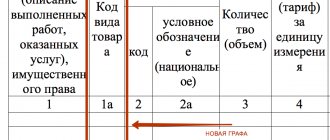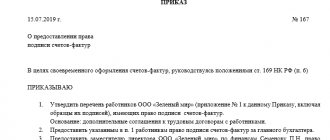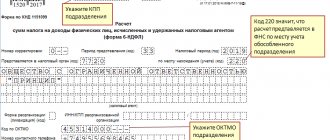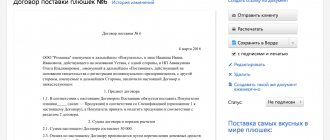Peculiarities
More information about how and what details should be indicated in various types of invoices can be found here.
Numbering
Primary requirements:
- numbers must be sequential;
- numbering ascending;
- eliminating the possibility of drawing up two invoices with the same numbers in different departments.
The taxpayer has the right to choose the order in which invoice numbers are issued, as well as the period from which numbering begins (year, quarter, month).
Letter of the Ministry of Taxes and Taxes of the Russian Federation 05.21.2001 N VG-6-03/404 “On the use of invoices when calculating value added tax” establishes the principles for numbering OP invoices, which allows solving this problem in two ways:
- Creation of number reserves for each department.
- Adding an internal department index to the number.
Read about what invoice numbers are here.
Responsibilities of the parent company for VAT
Even if a company conducts business through a wide network of separate divisions, all VAT responsibilities belong to the parent company.
She pays VAT in full only at her place of registration. VAT is not paid at the place of registration of separate divisions.
A breakdown into separate divisions is not required in the VAT return either. The report is compiled for the company as a whole, including data from separate divisions on taxable transactions and tax deductions. It is represented by the parent company also at its place of registration.
The thing is that VAT payers are legal entities. A separate division of a company is not a legal entity. Therefore, it cannot be an independent VAT payer with all the responsibilities. But divisions have the right to issue invoices, and on behalf of the parent organization. And they can receive goods too. This also determines some features of the design of invoices.
Exhibition rules
- Registration of an invoice (hereinafter referred to as S-F) in the sales book.
- S-F itself is discharged only after:
- shipment of goods;
- acceptance by the customer of the work or service;
- after receiving the advance.
- An invoice can be issued both in paper and electronic form, while the issuance of an electronic invoice occurs through a special organization - an electronic document management operator (clause 1.3 Order of the Ministry of Finance of the Russian Federation dated November 10, 2015 N174N).
- The paper document is printed in two copies for the buyer and the seller (a standard invoice form in Word and Excel format for printing a paper document can be found here).
- The period for issuing is limited to 5 days from the date of shipment and receipt of the advance payment (you will learn about the time frame within which an invoice must be issued to the buyer in this material).
The following publications from our experts will help you fill out your invoice correctly:
- What is a document code?
- How to correctly issue an invoice for an advance payment, for services, as well as for the return of goods to the supplier?
Which checkpoint should be indicated on the invoice?
Questions often arise related to the generation of invoices by an organization registered as the largest taxpayer; which checkpoint should be indicated in the relevant information fields of this document?
The answer to this question is clear: when filling out the invoice, in line “2b” you should enter the checkpoint assigned to the business entity as the largest taxpayer (i.e., the identifier assigned by the interregional inspectorate), and in line “3” - the registration address, according to location.
This conclusion was justified in the letter of the Ministry of Finance No. 03-07-09/49236 dated August 20, 2015. It states that business entities registered as major taxpayers submit a VAT return directly to the tax authority where it was registered in this status, and for productive administration of this type of tax, it is the checkpoint assigned in the interregional Federal Tax Service that should be use when generating an invoice.
Decor
- In the line “Invoice No.” the serial number of the document is placed, and the department index is added to it.
- The date of formation of the Federation Council is indicated. The date in the invoice should not appear later than the date specified in the primary documentation (accounting journal).
- The “Correction” line is filled in only if corrections are made, and the date and number of the correction are indicated.
- In paragraph (2) “Seller” the name of the organization for which the OP is indicated. Example: Good Products LLC.
- Paragraph (2a) “Address” must contain the address of the seller, that is, the organization.
- Paragraph (2b) contains the TIN of the organization, but the checkpoint contains the TIN of a separate unit. Difficulties most often arise in filling out this item.
- Item (3) “Consignor” contains information about the remote unit, its name and address.
- Paragraph (4) “Consignee and his address” indicates the name and address of the company to which the goods were shipped, or its remote division.
- Paragraph (5) “To payment document No.” – enter the number of the payment documentation to which the SF is attached.
- In Clause (6) “Buyer” the name of the organization purchasing the goods is entered.
- Item (6a) “Address” contains information about the address of the purchasing organization.
- Paragraph (6b) “TIN/KPP - if the goods are sent to the buyer’s OP, then this line indicates the TIN of the organization itself and the KPP of the unit. If the Buyer and the Consignee are in the same place, then the organization’s checkpoint is written.
- Clause (7) “Currency: name, code.” You can see the code and name of the currency in the Decree of the State Standard of Russia dated December 25, 2000 N 405-st. Example: Russian ruble, 643. You can find out whether it is possible to issue an invoice in the currency of another country, where to find out and display such a code, from our special material.
- Next, a table is filled in with the listing and specification of the goods being shipped, its price, the amount of tax charged to the buyer, etc. The procedure for filling out the table is common for both the OP and for shipment directly from the parent organization.
- At the end of the document the signatures and stamps of the manager and chief accountant are affixed. In the situation of issuing an invoice by a remote unit, the head of the OP is required to have a power of attorney to sign it and affix stamps on behalf of the organization. The authorized representatives put their signatures in the lines “Head of the organization” and “Chief accountant”; next to it is written the transcript of the signature and the position of the signatory.
General information ↑
Officials involved in the preparation of the seller's invoice, as well as financial statements, need to carefully understand the following important issues:
- definitions;
- operating principles of separate units;
- legal grounds.
Definitions
The abbreviation KPP stands for registration code. It is a set of characters that is in addition to the regular TIN - Tax Identification Number.
An important feature of the registration code is that the same organization can have several checkpoints.
The reason for this is very simple - registration is sometimes carried out in several tax authorities and in different areas. In each case, an individual registration reason code is generated.
So, the checkpoint is assigned:
- at the place of registration of the legal entity itself;
- at the place of registration of separate divisions;
- in a region where a legal entity owns any property (real estate, cars).
An invoice is a strict reporting document necessary to reflect all the necessary information in accounting.
It must indicate the corresponding checkpoint. Moreover, it is precisely the department with the participation of which the sale, or vice versa, acceptance of any valuable property, goods, services is carried out.
You should remember this, since separate divisions have a registration reason code that differs from the checkpoint of the main enterprise.
How is the document presented if the branch is foreign?
In the situation of a division of a foreign company, the following scenarios are possible:
- If the foreign company that owns the OP is registered in the Russian Federation and is a tax payer, then the entire procedure for issuing the SF is consistent with Article 21 of the Tax Code of the Russian Federation and is similar to that given above.
- If a foreign company is not registered in the Russian Federation, but has branches on its territory, then it can pay VAT through a tax agent. This applies to those companies that do not have official representative offices, but enjoy the right to register with the Federal Tax Service to pay VAT.
- If a foreign organization has a permanent establishment in the Russian Federation, then paying VAT becomes its responsibility. In this case, in lines (2) “Seller”, (2a) “Address” and (2b) “TIN/KPP” the information of the permanent representative office of the foreign enterprise is indicated. If the representative office is not the shipper, then the checkpoint is introduced as a separate unit. (Letter of the Ministry of Finance of the Russian Federation dated April 30, 2008 No. 03-07-11/171.
Operating principles of a separate division ↑
A separate division is understood as any branch of a legal entity that meets the requirements specified in paragraph 2 of Article No. 11 of the Tax Code of the Russian Federation.
The list of requirements themselves is as follows:
| Isolation | Territorial nature |
| Presence of appropriately equipped workplaces | Which will be valid for more than one month and located outside the place of state registration |
| Activities are underway | Some kind |
| The employer himself carries out constant supervision | Behind the workplace itself |
To recognize a unit as separate, it must comply with all the points indicated above.
The process of registering organizations that have any separate divisions is announced in paragraph 1 of Article No. 83 of the Tax Code of the Russian Federation.
In this case, the checkpoint of a separate division in the invoice is an individual code assigned to a specific branch. Do not confuse the registration code of the main organization and its branch.
Legal grounds
The basis for generating an invoice is the following regulatory framework (Letters of the Ministry of Finance of the Russian Federation):
| No. 03-07-09/18318 dated 04/02/15 | When you make a mistake |
| No. 03-07-11/16655 dated 03/26/15 | Deadlines for issuing invoices |
| №03-07-14/18223 | About keeping a log book |
In addition to the letters indicated above, it is necessary not to forget about the relevant articles of the Tax Code of the Russian Federation:
| Article No. 169 of the Tax Code of the Russian Federation | The most important points regarding the invoice are highlighted |
| Article No. 84 of the Tax Code of the Russian Federation | Regulates the procedure for registration at the place of territorial location and assignment of checkpoints |
Some letters and articles of the Tax Code do not specifically say anything directly about the issuance of an invoice by a separate division, but it is imperative to know their content.
For a sample of filling out an invoice without VAT, see the article: sample of filling out an invoice. Read how to create an invoice electronically here.
Since they indirectly affect the order of filling out this document, as well as the data entered into it. In particular, this applies to checkpoints.
It is worth paying attention to the study of federal legislation and its following sections:
- Law No. 185-FZ of December 23, 2003;
- Law No. 229-FZ of July 27, 2010;
- Law No. 347-FZ of 04.11.14;
- Law No. 248-FZ of July 23, 2013
All the federal laws mentioned above cover various nuances that relate to the procedure for filling out a document of the type in question.
Moreover, they concern the most complex and intractable situations (designation of checkpoints after liquidation and other similar things).
Blog
Question: The selling organization received an advance payment for the goods from the parent organization - the buyer. According to the terms of the contract, the goods will be shipped to a separate division of the buyer (its checkpoint is specified in the contract). Should the checkpoint of the parent organization - the buyer or its separate division be indicated to the seller in line 6b of the invoice issued upon receipt of the advance? Answer: If the selling organization received an advance for the goods from the parent organization - the buyer, but according to the terms of the contract, the goods will be shipped to a separate division of the buyer (its checkpoint is indicated in the contract), then, in our opinion, in line 6b of the invoice issued When receiving an advance, the seller should indicate the checkpoint of the buyer's separate division. Rationale: In accordance with paragraphs. “l” clause 1 of the Rules for filling out an invoice used in calculations for value added tax (approved by Decree of the Government of the Russian Federation of December 26, 2011 N 1137) (hereinafter referred to as the Rules), line 6b of the invoice indicates the taxpayer identification number and reason code for registration of the taxpayer-buyer. The Rules do not provide for any special features of filling out an invoice when receiving an advance payment for goods from the parent organization - the buyer and the subsequent shipment of the goods by the seller to a separate division of the buyer. The Letter of the Ministry of Finance of Russia dated 04.05.2016 N 03-07-09/25719 states that in the case of delivery of goods to a separate division of the purchasing organization, in line 4 “Consignee and his address” of the invoice, the name and address of the corresponding separate division are indicated in the lines 6 “Buyer” and 6a “Address” of the invoice indicate the data of the parent organization, in line 6b “TIN/KPP of the buyer” the KPP of the corresponding separate division is indicated. In the situation under consideration, we are not talking about filling out an invoice when shipping goods to a separate department of the buyer (as in the specified Letter), but about filling out an invoice issued upon receipt of an advance payment for the upcoming shipment of goods. However, at the time of receipt of the advance from the parent organization - the buyer, the seller, based on the terms of the contract, knows that the goods will be shipped to a separate division of the buyer. In this regard, in our opinion, the seller has the right to apply the above approach of the Russian Ministry of Finance when filling out an invoice for the advance received. Based on the foregoing, we believe that if the selling organization has received an advance for the goods from the parent organization - the buyer, but according to the terms of the contract, the goods will be shipped to a separate division of the buyer (its checkpoint is indicated in the contract), in line 6b of the invoice issued at upon receipt of an advance, the seller should indicate the checkpoint of the buyer’s separate division. In addition, the norms of Ch. 21 “Value Added Tax” of the Tax Code of the Russian Federation, the reflection of additional details (information) in invoices is not prohibited. Therefore, if goods (work, services) are purchased by an organization through its separate divisions, the indication in the invoice of the checkpoint of the unit and the checkpoint of the purchasing organization is not a violation of the current procedure for issuing an invoice (Letter of the Ministry of Finance of Russia dated July 24, 2013 N 03- 07-09/29204). At the same time, according to paragraph. 2 p. 2 art. 169 of the Tax Code of the Russian Federation, errors in invoices that do not prevent tax authorities from identifying the seller, buyer of goods (work, services), property rights, the name of goods (work, services), property rights, their value, as well as the tax rate and the amount of tax presented to the buyer is not a basis for refusing to accept VAT amounts for deduction. Consequently, the seller’s incorrect indication of the buyer’s checkpoint on the invoice does not prevent the buyer from deducting VAT on this invoice.
Regional information center
16.08.2017






